The Business Environment of Tesco and Oxfam
VerifiedAdded on 2021/01/01
|13
|4156
|290
AI Summary
Contribute Materials
Your contribution can guide someone’s learning journey. Share your
documents today.

THE
BUSINESS
ENVIRONMENT
BUSINESS
ENVIRONMENT
Secure Best Marks with AI Grader
Need help grading? Try our AI Grader for instant feedback on your assignments.
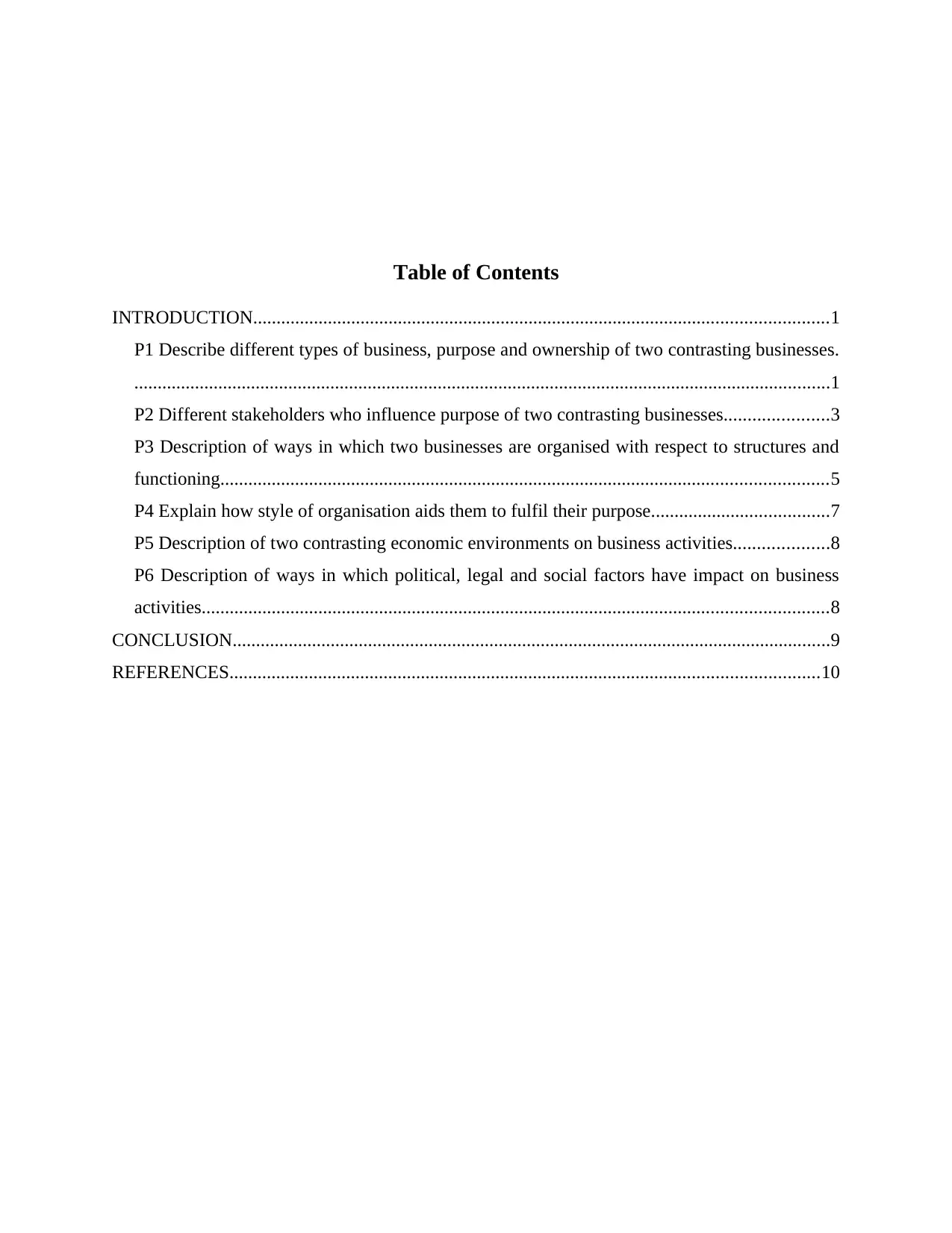
Table of Contents
INTRODUCTION...........................................................................................................................1
P1 Describe different types of business, purpose and ownership of two contrasting businesses.
.....................................................................................................................................................1
P2 Different stakeholders who influence purpose of two contrasting businesses......................3
P3 Description of ways in which two businesses are organised with respect to structures and
functioning..................................................................................................................................5
P4 Explain how style of organisation aids them to fulfil their purpose......................................7
P5 Description of two contrasting economic environments on business activities....................8
P6 Description of ways in which political, legal and social factors have impact on business
activities......................................................................................................................................8
CONCLUSION................................................................................................................................9
REFERENCES..............................................................................................................................10
INTRODUCTION...........................................................................................................................1
P1 Describe different types of business, purpose and ownership of two contrasting businesses.
.....................................................................................................................................................1
P2 Different stakeholders who influence purpose of two contrasting businesses......................3
P3 Description of ways in which two businesses are organised with respect to structures and
functioning..................................................................................................................................5
P4 Explain how style of organisation aids them to fulfil their purpose......................................7
P5 Description of two contrasting economic environments on business activities....................8
P6 Description of ways in which political, legal and social factors have impact on business
activities......................................................................................................................................8
CONCLUSION................................................................................................................................9
REFERENCES..............................................................................................................................10


INTRODUCTION
Business environment refers to accumulation of individuals, entities and different factors
which may or may not be in control of organisation but may have significant impact on growth,
profitability, survival and performance (Business environment, 2018). In this report two
organisations are considered they are TESCO and Oxfam. TESCO is a British multinational
grocery and merchandise retailer. It is a private organisation which is headquartered in Welwyn
Garden City Hertfordshire, England. Oxfam is a voluntary organisation which is a alliance of 20
autonomous charitable organisations which focus on elimination of global poverty. It is a non-
profit group which was founded in Oxford, England. This report describes different type of
business, their purpose and ownership of
two contrasting business. Furthermore, different stakeholders are represented who have
significant influence on organisation. Apart from this, way in which businesses are organised is
discussed and way in which their style helps organisation to accomplish their purpose. At last,
different political, legal and social factors are analysed which impact business.
P1 Describe different types of business, purpose and ownership of two contrasting businesses.
There are two different types of businesses, they are profit and non-profit businesses.
Profitable business are the one who generates more money then what they have spend. They use
different methods by which they can enhance their profit. Non-profit businesses are devoted to
promoting or advocating a social cause for having shared point of view. These organisations
make use of their excess of the revenue for achieving their eventual objectives. Tesco is a
profitable organisation and Oxfam is non-profitable organisation (Hilton and Platt, 2013) .
TESCO: It is a British multinational groceries and merchandise retailer organisation. It
was founded in 1911 and is headquartered in Welwyn Garden City, Hertfordshire, England,
United Kingdom. It was founded by Jack Cohen. It is a profit organisation which implies that it
is private which executes their business for generating profit by a individual, partnerships or by
association. They are operating in many countries with more than 6553 shops. This is spread
almost in all parts of UK.
Purpose: Tesco has aimed at providing value to their customers by which they can gain
customers loyalty. Customers of Tesco are expecting high quality products from them at
1
Business environment refers to accumulation of individuals, entities and different factors
which may or may not be in control of organisation but may have significant impact on growth,
profitability, survival and performance (Business environment, 2018). In this report two
organisations are considered they are TESCO and Oxfam. TESCO is a British multinational
grocery and merchandise retailer. It is a private organisation which is headquartered in Welwyn
Garden City Hertfordshire, England. Oxfam is a voluntary organisation which is a alliance of 20
autonomous charitable organisations which focus on elimination of global poverty. It is a non-
profit group which was founded in Oxford, England. This report describes different type of
business, their purpose and ownership of
two contrasting business. Furthermore, different stakeholders are represented who have
significant influence on organisation. Apart from this, way in which businesses are organised is
discussed and way in which their style helps organisation to accomplish their purpose. At last,
different political, legal and social factors are analysed which impact business.
P1 Describe different types of business, purpose and ownership of two contrasting businesses.
There are two different types of businesses, they are profit and non-profit businesses.
Profitable business are the one who generates more money then what they have spend. They use
different methods by which they can enhance their profit. Non-profit businesses are devoted to
promoting or advocating a social cause for having shared point of view. These organisations
make use of their excess of the revenue for achieving their eventual objectives. Tesco is a
profitable organisation and Oxfam is non-profitable organisation (Hilton and Platt, 2013) .
TESCO: It is a British multinational groceries and merchandise retailer organisation. It
was founded in 1911 and is headquartered in Welwyn Garden City, Hertfordshire, England,
United Kingdom. It was founded by Jack Cohen. It is a profit organisation which implies that it
is private which executes their business for generating profit by a individual, partnerships or by
association. They are operating in many countries with more than 6553 shops. This is spread
almost in all parts of UK.
Purpose: Tesco has aimed at providing value to their customers by which they can gain
customers loyalty. Customers of Tesco are expecting high quality products from them at
1
Secure Best Marks with AI Grader
Need help grading? Try our AI Grader for instant feedback on your assignments.

reasonable prices. For this management of Tesco has ensured that they provide their customers
with high quality services and fulfil their demands.
Nature: Jack Cohen has founded Tesco in 1919. First Tesco shop was opened in 1931 in Burnt
Oak, Barnet. They are offering superstore, hypermarket, supermarket and convenience shop.
Their revenue is more than £55.9 billion. They have formulated strategies to heighten loyalty of
customers.
Private limited company: It is a type of organisation which provides constricted obligation,
legal assets for their shareholders but with definite restraint on their ownership. It is a partnership
firm. Major ownership restrictions are mentioned here:
Shareholders do not content their shares within public when stock exchange occurs.
Number of shareholders are fixed i.e. 50 and cannot exceed this number. Apart from
this, shares can neither be transferred nor be sold without they are being offered to
other shareholders for purchase (Bharadwaj and et. al., 2013).
Limited liability or constricted obligation are defined with state for which shareholders are
responsible for liabilities of company only to have minimal value of their shares. There is
essential protection for shareholders within organisation by which they cannot lose their value of
investment. Apart from this, there is no security against deceitful trading. Her majesty's revenue
and customs (HMRC) is a non-ministerial department of government of UK which collect taxes
form private business which are carrying out their operations within UK.
Ownership: In case of profitable organisation i.e. profit is shared between different
shareholders, they are employees, partners or individuals who are effective part of organisation.
OXFAM: It is a fusion of 20 self-reliant charitable organisations whose focus is to
provide comfort from global poverty. It is a non-profitable organisation which was established in
1942. It is a international non-governmental organisation which is focussing on eradication of
poverty, relief from disaster, pro-migration, policy research and advocacy. They provide their
services worldwide. Executive director of Oxfam is Winnie Byanyima from 2013.
Purpose: They want to build an lasting solution for injustice of poverty. They want to be a part
of global movement for alterations, one which authorise individuals to make a future which is
just, free from poverty and secure. They have a vision in which individuals can determine
decisions which will have significant impact on their lives and are responsible as citizen of world
where everyone is treated equally and are valued (Berg and Kilambi, 2014).
2
with high quality services and fulfil their demands.
Nature: Jack Cohen has founded Tesco in 1919. First Tesco shop was opened in 1931 in Burnt
Oak, Barnet. They are offering superstore, hypermarket, supermarket and convenience shop.
Their revenue is more than £55.9 billion. They have formulated strategies to heighten loyalty of
customers.
Private limited company: It is a type of organisation which provides constricted obligation,
legal assets for their shareholders but with definite restraint on their ownership. It is a partnership
firm. Major ownership restrictions are mentioned here:
Shareholders do not content their shares within public when stock exchange occurs.
Number of shareholders are fixed i.e. 50 and cannot exceed this number. Apart from
this, shares can neither be transferred nor be sold without they are being offered to
other shareholders for purchase (Bharadwaj and et. al., 2013).
Limited liability or constricted obligation are defined with state for which shareholders are
responsible for liabilities of company only to have minimal value of their shares. There is
essential protection for shareholders within organisation by which they cannot lose their value of
investment. Apart from this, there is no security against deceitful trading. Her majesty's revenue
and customs (HMRC) is a non-ministerial department of government of UK which collect taxes
form private business which are carrying out their operations within UK.
Ownership: In case of profitable organisation i.e. profit is shared between different
shareholders, they are employees, partners or individuals who are effective part of organisation.
OXFAM: It is a fusion of 20 self-reliant charitable organisations whose focus is to
provide comfort from global poverty. It is a non-profitable organisation which was established in
1942. It is a international non-governmental organisation which is focussing on eradication of
poverty, relief from disaster, pro-migration, policy research and advocacy. They provide their
services worldwide. Executive director of Oxfam is Winnie Byanyima from 2013.
Purpose: They want to build an lasting solution for injustice of poverty. They want to be a part
of global movement for alterations, one which authorise individuals to make a future which is
just, free from poverty and secure. They have a vision in which individuals can determine
decisions which will have significant impact on their lives and are responsible as citizen of world
where everyone is treated equally and are valued (Berg and Kilambi, 2014).
2
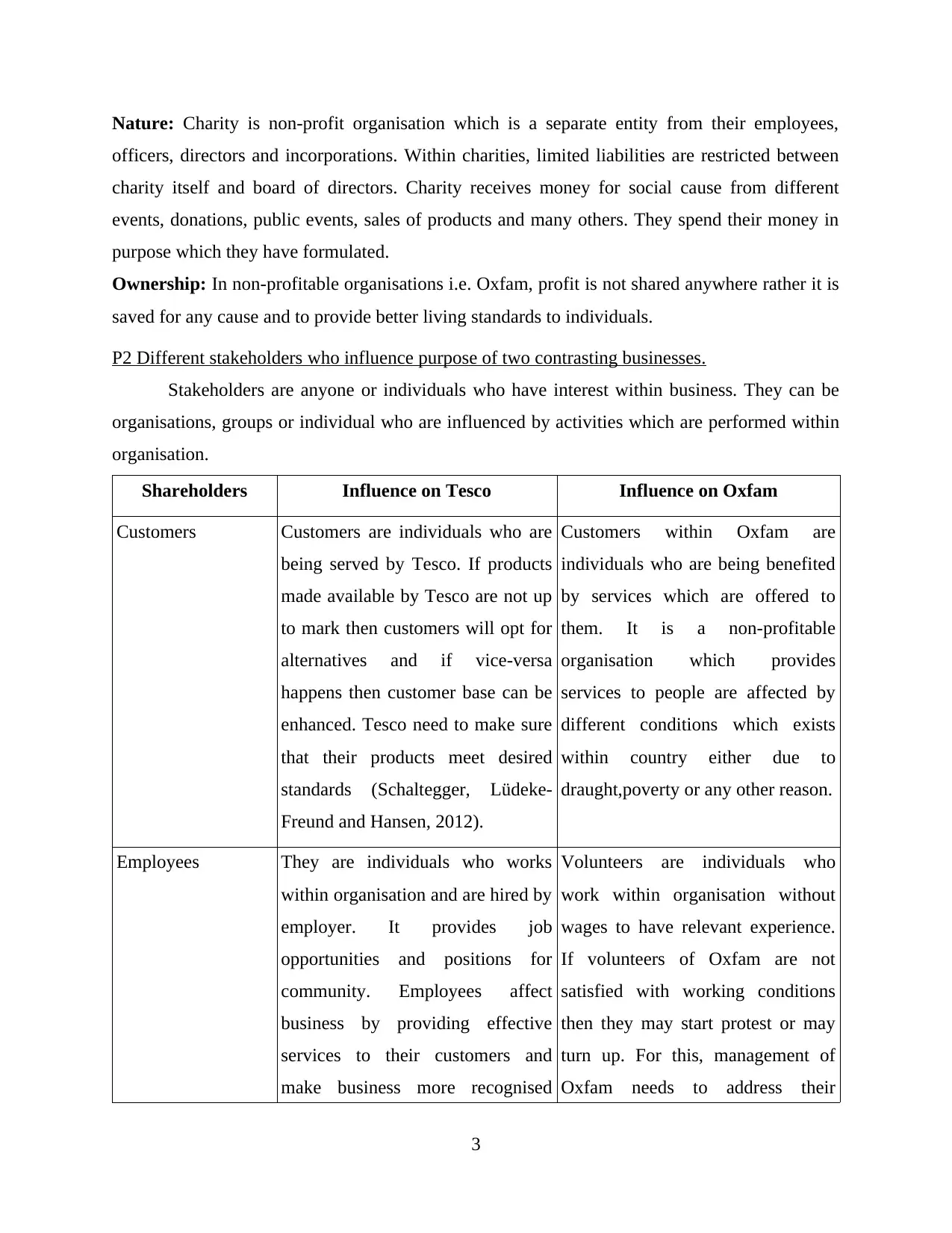
Nature: Charity is non-profit organisation which is a separate entity from their employees,
officers, directors and incorporations. Within charities, limited liabilities are restricted between
charity itself and board of directors. Charity receives money for social cause from different
events, donations, public events, sales of products and many others. They spend their money in
purpose which they have formulated.
Ownership: In non-profitable organisations i.e. Oxfam, profit is not shared anywhere rather it is
saved for any cause and to provide better living standards to individuals.
P2 Different stakeholders who influence purpose of two contrasting businesses.
Stakeholders are anyone or individuals who have interest within business. They can be
organisations, groups or individual who are influenced by activities which are performed within
organisation.
Shareholders Influence on Tesco Influence on Oxfam
Customers Customers are individuals who are
being served by Tesco. If products
made available by Tesco are not up
to mark then customers will opt for
alternatives and if vice-versa
happens then customer base can be
enhanced. Tesco need to make sure
that their products meet desired
standards (Schaltegger, Lüdeke-
Freund and Hansen, 2012).
Customers within Oxfam are
individuals who are being benefited
by services which are offered to
them. It is a non-profitable
organisation which provides
services to people are affected by
different conditions which exists
within country either due to
draught,poverty or any other reason.
Employees They are individuals who works
within organisation and are hired by
employer. It provides job
opportunities and positions for
community. Employees affect
business by providing effective
services to their customers and
make business more recognised
Volunteers are individuals who
work within organisation without
wages to have relevant experience.
If volunteers of Oxfam are not
satisfied with working conditions
then they may start protest or may
turn up. For this, management of
Oxfam needs to address their
3
officers, directors and incorporations. Within charities, limited liabilities are restricted between
charity itself and board of directors. Charity receives money for social cause from different
events, donations, public events, sales of products and many others. They spend their money in
purpose which they have formulated.
Ownership: In non-profitable organisations i.e. Oxfam, profit is not shared anywhere rather it is
saved for any cause and to provide better living standards to individuals.
P2 Different stakeholders who influence purpose of two contrasting businesses.
Stakeholders are anyone or individuals who have interest within business. They can be
organisations, groups or individual who are influenced by activities which are performed within
organisation.
Shareholders Influence on Tesco Influence on Oxfam
Customers Customers are individuals who are
being served by Tesco. If products
made available by Tesco are not up
to mark then customers will opt for
alternatives and if vice-versa
happens then customer base can be
enhanced. Tesco need to make sure
that their products meet desired
standards (Schaltegger, Lüdeke-
Freund and Hansen, 2012).
Customers within Oxfam are
individuals who are being benefited
by services which are offered to
them. It is a non-profitable
organisation which provides
services to people are affected by
different conditions which exists
within country either due to
draught,poverty or any other reason.
Employees They are individuals who works
within organisation and are hired by
employer. It provides job
opportunities and positions for
community. Employees affect
business by providing effective
services to their customers and
make business more recognised
Volunteers are individuals who
work within organisation without
wages to have relevant experience.
If volunteers of Oxfam are not
satisfied with working conditions
then they may start protest or may
turn up. For this, management of
Oxfam needs to address their
3

within community. problem so that such kind of
situation do not arises.
Owners They are interested in business as
they want to make profit, this profit
can be used to invest in new
services which can be of interest to
local community and customers.
They have complete control on
business functionalities and
activities.
Oxfam have trustees who manages
charity and takes different projects
by which hey can raise their funds.
They give their suppliers request
related to what they need and make
use of donations so that they can
provide effective services. Trustees
of Oxfam affects the way in which
they operate and what they want to
do, so that they can provide services
to public (Ballard and et.al., 2012) .
Suppliers They are individuals whose
business is to provide products or
services. Suppliers of Tesco wants
that have firm orders and receive
payments within time. Their interest
is to get represented by Tesco with
advanced quality and business
which pay them agile.
They supply goods and services.
Oxfam rely on their suppliers which
can be donors or vendors for
materials like first aid kit, food,
clothes, etc. If they are not paid on
timely basis, then they will stop
rendering their services, so Oxfam
need to ensure that suppliers are
being paid within time.
Trade unions Trade unions are organisation who
comprises of union leaders and
workers who are allied to assist and
boost their interest. The main
interest of trade unions within
Tesco is to generate higher wages
and provide effective working
environment to their employees
Oxfam conducts meeting with trade
unions or non-governmental
organisations to acknowledge and
reply to concerned issues. It
includes what people are expecting ,
future plans, etc. This will aid
Oxfam to reach their aims,
objectives, increase profits by which
4
situation do not arises.
Owners They are interested in business as
they want to make profit, this profit
can be used to invest in new
services which can be of interest to
local community and customers.
They have complete control on
business functionalities and
activities.
Oxfam have trustees who manages
charity and takes different projects
by which hey can raise their funds.
They give their suppliers request
related to what they need and make
use of donations so that they can
provide effective services. Trustees
of Oxfam affects the way in which
they operate and what they want to
do, so that they can provide services
to public (Ballard and et.al., 2012) .
Suppliers They are individuals whose
business is to provide products or
services. Suppliers of Tesco wants
that have firm orders and receive
payments within time. Their interest
is to get represented by Tesco with
advanced quality and business
which pay them agile.
They supply goods and services.
Oxfam rely on their suppliers which
can be donors or vendors for
materials like first aid kit, food,
clothes, etc. If they are not paid on
timely basis, then they will stop
rendering their services, so Oxfam
need to ensure that suppliers are
being paid within time.
Trade unions Trade unions are organisation who
comprises of union leaders and
workers who are allied to assist and
boost their interest. The main
interest of trade unions within
Tesco is to generate higher wages
and provide effective working
environment to their employees
Oxfam conducts meeting with trade
unions or non-governmental
organisations to acknowledge and
reply to concerned issues. It
includes what people are expecting ,
future plans, etc. This will aid
Oxfam to reach their aims,
objectives, increase profits by which
4
Paraphrase This Document
Need a fresh take? Get an instant paraphrase of this document with our AI Paraphraser
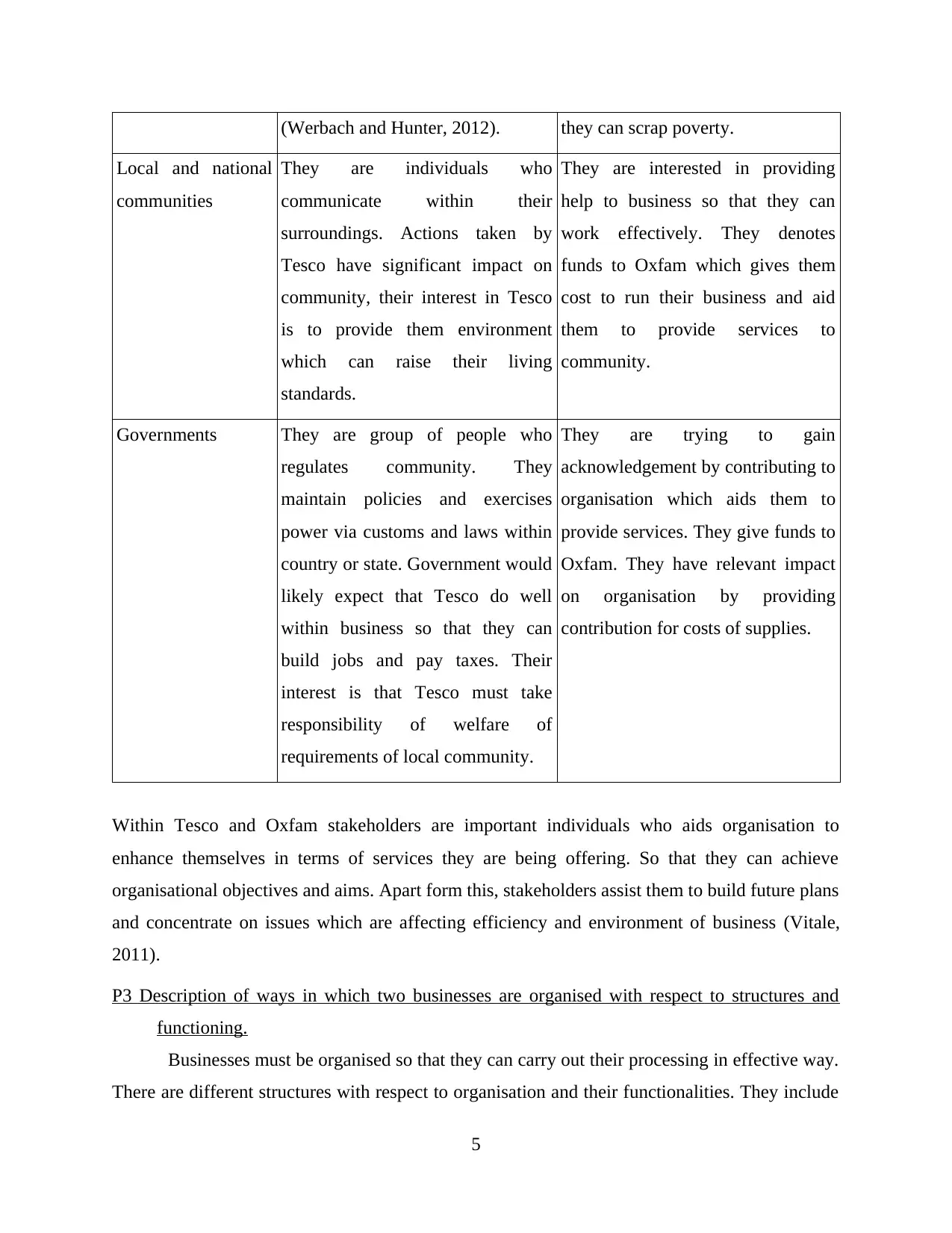
(Werbach and Hunter, 2012). they can scrap poverty.
Local and national
communities
They are individuals who
communicate within their
surroundings. Actions taken by
Tesco have significant impact on
community, their interest in Tesco
is to provide them environment
which can raise their living
standards.
They are interested in providing
help to business so that they can
work effectively. They denotes
funds to Oxfam which gives them
cost to run their business and aid
them to provide services to
community.
Governments They are group of people who
regulates community. They
maintain policies and exercises
power via customs and laws within
country or state. Government would
likely expect that Tesco do well
within business so that they can
build jobs and pay taxes. Their
interest is that Tesco must take
responsibility of welfare of
requirements of local community.
They are trying to gain
acknowledgement by contributing to
organisation which aids them to
provide services. They give funds to
Oxfam. They have relevant impact
on organisation by providing
contribution for costs of supplies.
Within Tesco and Oxfam stakeholders are important individuals who aids organisation to
enhance themselves in terms of services they are being offering. So that they can achieve
organisational objectives and aims. Apart form this, stakeholders assist them to build future plans
and concentrate on issues which are affecting efficiency and environment of business (Vitale,
2011).
P3 Description of ways in which two businesses are organised with respect to structures and
functioning.
Businesses must be organised so that they can carry out their processing in effective way.
There are different structures with respect to organisation and their functionalities. They include
5
Local and national
communities
They are individuals who
communicate within their
surroundings. Actions taken by
Tesco have significant impact on
community, their interest in Tesco
is to provide them environment
which can raise their living
standards.
They are interested in providing
help to business so that they can
work effectively. They denotes
funds to Oxfam which gives them
cost to run their business and aid
them to provide services to
community.
Governments They are group of people who
regulates community. They
maintain policies and exercises
power via customs and laws within
country or state. Government would
likely expect that Tesco do well
within business so that they can
build jobs and pay taxes. Their
interest is that Tesco must take
responsibility of welfare of
requirements of local community.
They are trying to gain
acknowledgement by contributing to
organisation which aids them to
provide services. They give funds to
Oxfam. They have relevant impact
on organisation by providing
contribution for costs of supplies.
Within Tesco and Oxfam stakeholders are important individuals who aids organisation to
enhance themselves in terms of services they are being offering. So that they can achieve
organisational objectives and aims. Apart form this, stakeholders assist them to build future plans
and concentrate on issues which are affecting efficiency and environment of business (Vitale,
2011).
P3 Description of ways in which two businesses are organised with respect to structures and
functioning.
Businesses must be organised so that they can carry out their processing in effective way.
There are different structures with respect to organisation and their functionalities. They include
5
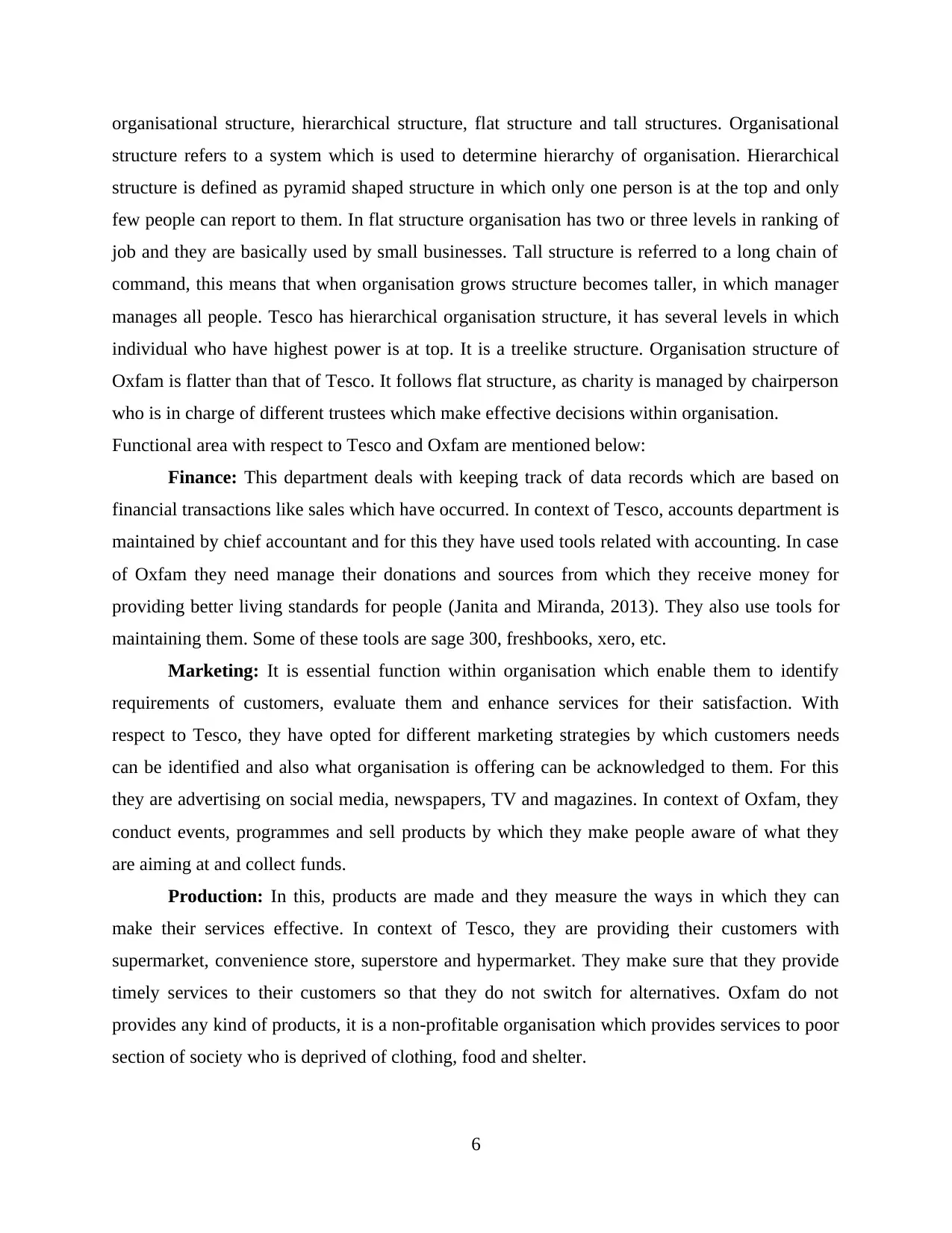
organisational structure, hierarchical structure, flat structure and tall structures. Organisational
structure refers to a system which is used to determine hierarchy of organisation. Hierarchical
structure is defined as pyramid shaped structure in which only one person is at the top and only
few people can report to them. In flat structure organisation has two or three levels in ranking of
job and they are basically used by small businesses. Tall structure is referred to a long chain of
command, this means that when organisation grows structure becomes taller, in which manager
manages all people. Tesco has hierarchical organisation structure, it has several levels in which
individual who have highest power is at top. It is a treelike structure. Organisation structure of
Oxfam is flatter than that of Tesco. It follows flat structure, as charity is managed by chairperson
who is in charge of different trustees which make effective decisions within organisation.
Functional area with respect to Tesco and Oxfam are mentioned below:
Finance: This department deals with keeping track of data records which are based on
financial transactions like sales which have occurred. In context of Tesco, accounts department is
maintained by chief accountant and for this they have used tools related with accounting. In case
of Oxfam they need manage their donations and sources from which they receive money for
providing better living standards for people (Janita and Miranda, 2013). They also use tools for
maintaining them. Some of these tools are sage 300, freshbooks, xero, etc.
Marketing: It is essential function within organisation which enable them to identify
requirements of customers, evaluate them and enhance services for their satisfaction. With
respect to Tesco, they have opted for different marketing strategies by which customers needs
can be identified and also what organisation is offering can be acknowledged to them. For this
they are advertising on social media, newspapers, TV and magazines. In context of Oxfam, they
conduct events, programmes and sell products by which they make people aware of what they
are aiming at and collect funds.
Production: In this, products are made and they measure the ways in which they can
make their services effective. In context of Tesco, they are providing their customers with
supermarket, convenience store, superstore and hypermarket. They make sure that they provide
timely services to their customers so that they do not switch for alternatives. Oxfam do not
provides any kind of products, it is a non-profitable organisation which provides services to poor
section of society who is deprived of clothing, food and shelter.
6
structure refers to a system which is used to determine hierarchy of organisation. Hierarchical
structure is defined as pyramid shaped structure in which only one person is at the top and only
few people can report to them. In flat structure organisation has two or three levels in ranking of
job and they are basically used by small businesses. Tall structure is referred to a long chain of
command, this means that when organisation grows structure becomes taller, in which manager
manages all people. Tesco has hierarchical organisation structure, it has several levels in which
individual who have highest power is at top. It is a treelike structure. Organisation structure of
Oxfam is flatter than that of Tesco. It follows flat structure, as charity is managed by chairperson
who is in charge of different trustees which make effective decisions within organisation.
Functional area with respect to Tesco and Oxfam are mentioned below:
Finance: This department deals with keeping track of data records which are based on
financial transactions like sales which have occurred. In context of Tesco, accounts department is
maintained by chief accountant and for this they have used tools related with accounting. In case
of Oxfam they need manage their donations and sources from which they receive money for
providing better living standards for people (Janita and Miranda, 2013). They also use tools for
maintaining them. Some of these tools are sage 300, freshbooks, xero, etc.
Marketing: It is essential function within organisation which enable them to identify
requirements of customers, evaluate them and enhance services for their satisfaction. With
respect to Tesco, they have opted for different marketing strategies by which customers needs
can be identified and also what organisation is offering can be acknowledged to them. For this
they are advertising on social media, newspapers, TV and magazines. In context of Oxfam, they
conduct events, programmes and sell products by which they make people aware of what they
are aiming at and collect funds.
Production: In this, products are made and they measure the ways in which they can
make their services effective. In context of Tesco, they are providing their customers with
supermarket, convenience store, superstore and hypermarket. They make sure that they provide
timely services to their customers so that they do not switch for alternatives. Oxfam do not
provides any kind of products, it is a non-profitable organisation which provides services to poor
section of society who is deprived of clothing, food and shelter.
6
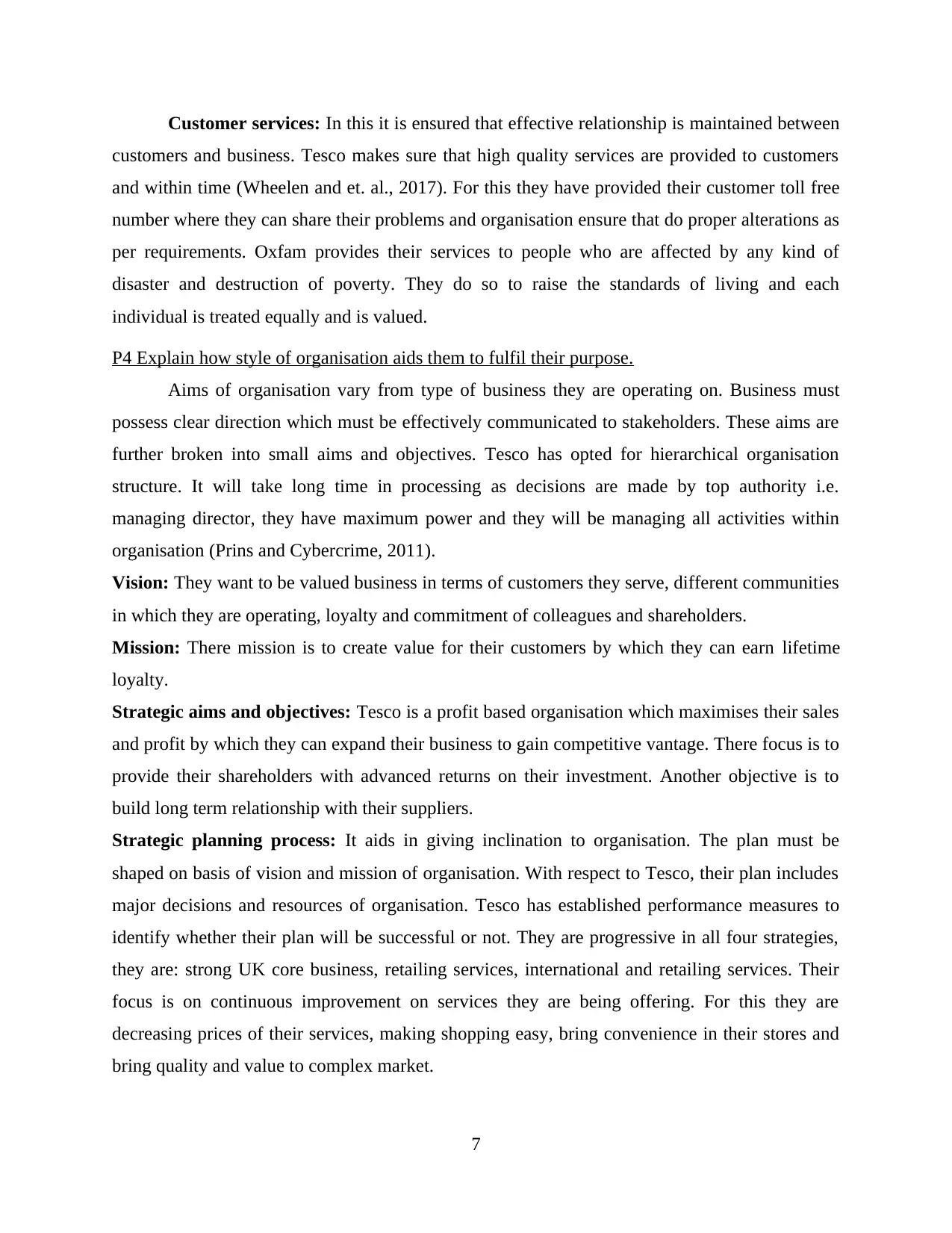
Customer services: In this it is ensured that effective relationship is maintained between
customers and business. Tesco makes sure that high quality services are provided to customers
and within time (Wheelen and et. al., 2017). For this they have provided their customer toll free
number where they can share their problems and organisation ensure that do proper alterations as
per requirements. Oxfam provides their services to people who are affected by any kind of
disaster and destruction of poverty. They do so to raise the standards of living and each
individual is treated equally and is valued.
P4 Explain how style of organisation aids them to fulfil their purpose.
Aims of organisation vary from type of business they are operating on. Business must
possess clear direction which must be effectively communicated to stakeholders. These aims are
further broken into small aims and objectives. Tesco has opted for hierarchical organisation
structure. It will take long time in processing as decisions are made by top authority i.e.
managing director, they have maximum power and they will be managing all activities within
organisation (Prins and Cybercrime, 2011).
Vision: They want to be valued business in terms of customers they serve, different communities
in which they are operating, loyalty and commitment of colleagues and shareholders.
Mission: There mission is to create value for their customers by which they can earn lifetime
loyalty.
Strategic aims and objectives: Tesco is a profit based organisation which maximises their sales
and profit by which they can expand their business to gain competitive vantage. There focus is to
provide their shareholders with advanced returns on their investment. Another objective is to
build long term relationship with their suppliers.
Strategic planning process: It aids in giving inclination to organisation. The plan must be
shaped on basis of vision and mission of organisation. With respect to Tesco, their plan includes
major decisions and resources of organisation. Tesco has established performance measures to
identify whether their plan will be successful or not. They are progressive in all four strategies,
they are: strong UK core business, retailing services, international and retailing services. Their
focus is on continuous improvement on services they are being offering. For this they are
decreasing prices of their services, making shopping easy, bring convenience in their stores and
bring quality and value to complex market.
7
customers and business. Tesco makes sure that high quality services are provided to customers
and within time (Wheelen and et. al., 2017). For this they have provided their customer toll free
number where they can share their problems and organisation ensure that do proper alterations as
per requirements. Oxfam provides their services to people who are affected by any kind of
disaster and destruction of poverty. They do so to raise the standards of living and each
individual is treated equally and is valued.
P4 Explain how style of organisation aids them to fulfil their purpose.
Aims of organisation vary from type of business they are operating on. Business must
possess clear direction which must be effectively communicated to stakeholders. These aims are
further broken into small aims and objectives. Tesco has opted for hierarchical organisation
structure. It will take long time in processing as decisions are made by top authority i.e.
managing director, they have maximum power and they will be managing all activities within
organisation (Prins and Cybercrime, 2011).
Vision: They want to be valued business in terms of customers they serve, different communities
in which they are operating, loyalty and commitment of colleagues and shareholders.
Mission: There mission is to create value for their customers by which they can earn lifetime
loyalty.
Strategic aims and objectives: Tesco is a profit based organisation which maximises their sales
and profit by which they can expand their business to gain competitive vantage. There focus is to
provide their shareholders with advanced returns on their investment. Another objective is to
build long term relationship with their suppliers.
Strategic planning process: It aids in giving inclination to organisation. The plan must be
shaped on basis of vision and mission of organisation. With respect to Tesco, their plan includes
major decisions and resources of organisation. Tesco has established performance measures to
identify whether their plan will be successful or not. They are progressive in all four strategies,
they are: strong UK core business, retailing services, international and retailing services. Their
focus is on continuous improvement on services they are being offering. For this they are
decreasing prices of their services, making shopping easy, bring convenience in their stores and
bring quality and value to complex market.
7
Secure Best Marks with AI Grader
Need help grading? Try our AI Grader for instant feedback on your assignments.
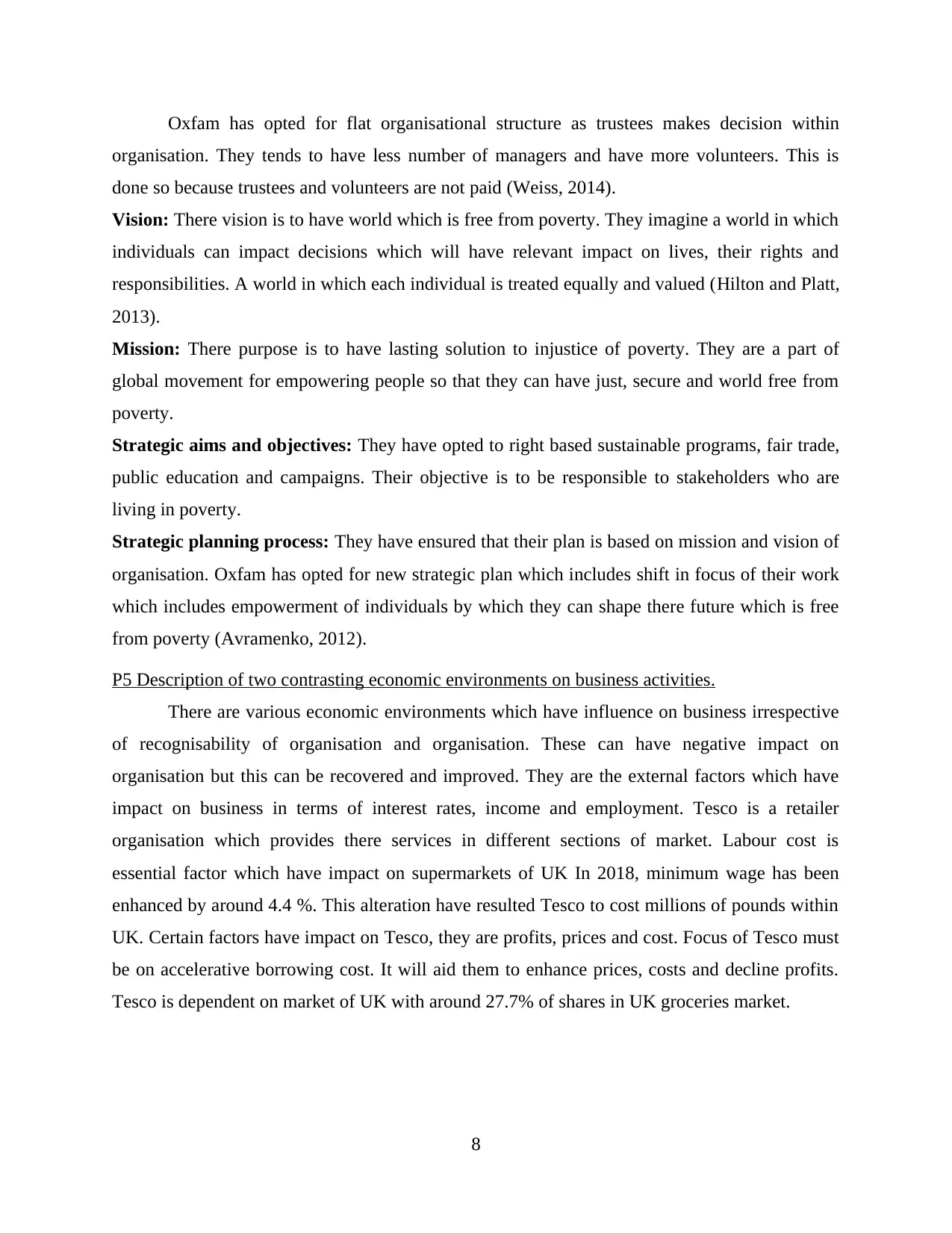
Oxfam has opted for flat organisational structure as trustees makes decision within
organisation. They tends to have less number of managers and have more volunteers. This is
done so because trustees and volunteers are not paid (Weiss, 2014).
Vision: There vision is to have world which is free from poverty. They imagine a world in which
individuals can impact decisions which will have relevant impact on lives, their rights and
responsibilities. A world in which each individual is treated equally and valued (Hilton and Platt,
2013).
Mission: There purpose is to have lasting solution to injustice of poverty. They are a part of
global movement for empowering people so that they can have just, secure and world free from
poverty.
Strategic aims and objectives: They have opted to right based sustainable programs, fair trade,
public education and campaigns. Their objective is to be responsible to stakeholders who are
living in poverty.
Strategic planning process: They have ensured that their plan is based on mission and vision of
organisation. Oxfam has opted for new strategic plan which includes shift in focus of their work
which includes empowerment of individuals by which they can shape there future which is free
from poverty (Avramenko, 2012).
P5 Description of two contrasting economic environments on business activities.
There are various economic environments which have influence on business irrespective
of recognisability of organisation and organisation. These can have negative impact on
organisation but this can be recovered and improved. They are the external factors which have
impact on business in terms of interest rates, income and employment. Tesco is a retailer
organisation which provides there services in different sections of market. Labour cost is
essential factor which have impact on supermarkets of UK In 2018, minimum wage has been
enhanced by around 4.4 %. This alteration have resulted Tesco to cost millions of pounds within
UK. Certain factors have impact on Tesco, they are profits, prices and cost. Focus of Tesco must
be on accelerative borrowing cost. It will aid them to enhance prices, costs and decline profits.
Tesco is dependent on market of UK with around 27.7% of shares in UK groceries market.
8
organisation. They tends to have less number of managers and have more volunteers. This is
done so because trustees and volunteers are not paid (Weiss, 2014).
Vision: There vision is to have world which is free from poverty. They imagine a world in which
individuals can impact decisions which will have relevant impact on lives, their rights and
responsibilities. A world in which each individual is treated equally and valued (Hilton and Platt,
2013).
Mission: There purpose is to have lasting solution to injustice of poverty. They are a part of
global movement for empowering people so that they can have just, secure and world free from
poverty.
Strategic aims and objectives: They have opted to right based sustainable programs, fair trade,
public education and campaigns. Their objective is to be responsible to stakeholders who are
living in poverty.
Strategic planning process: They have ensured that their plan is based on mission and vision of
organisation. Oxfam has opted for new strategic plan which includes shift in focus of their work
which includes empowerment of individuals by which they can shape there future which is free
from poverty (Avramenko, 2012).
P5 Description of two contrasting economic environments on business activities.
There are various economic environments which have influence on business irrespective
of recognisability of organisation and organisation. These can have negative impact on
organisation but this can be recovered and improved. They are the external factors which have
impact on business in terms of interest rates, income and employment. Tesco is a retailer
organisation which provides there services in different sections of market. Labour cost is
essential factor which have impact on supermarkets of UK In 2018, minimum wage has been
enhanced by around 4.4 %. This alteration have resulted Tesco to cost millions of pounds within
UK. Certain factors have impact on Tesco, they are profits, prices and cost. Focus of Tesco must
be on accelerative borrowing cost. It will aid them to enhance prices, costs and decline profits.
Tesco is dependent on market of UK with around 27.7% of shares in UK groceries market.
8
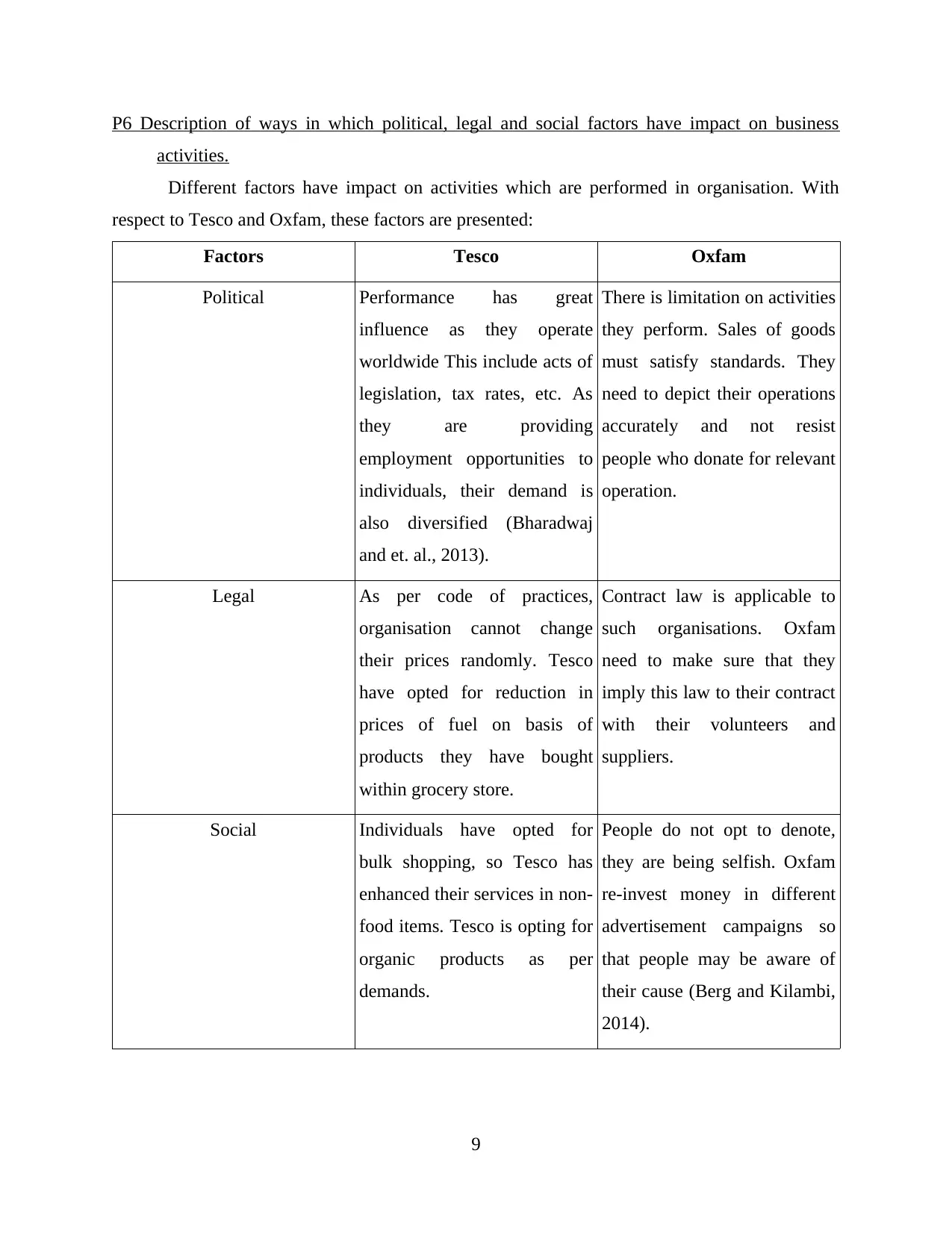
P6 Description of ways in which political, legal and social factors have impact on business
activities.
Different factors have impact on activities which are performed in organisation. With
respect to Tesco and Oxfam, these factors are presented:
Factors Tesco Oxfam
Political Performance has great
influence as they operate
worldwide This include acts of
legislation, tax rates, etc. As
they are providing
employment opportunities to
individuals, their demand is
also diversified (Bharadwaj
and et. al., 2013).
There is limitation on activities
they perform. Sales of goods
must satisfy standards. They
need to depict their operations
accurately and not resist
people who donate for relevant
operation.
Legal As per code of practices,
organisation cannot change
their prices randomly. Tesco
have opted for reduction in
prices of fuel on basis of
products they have bought
within grocery store.
Contract law is applicable to
such organisations. Oxfam
need to make sure that they
imply this law to their contract
with their volunteers and
suppliers.
Social Individuals have opted for
bulk shopping, so Tesco has
enhanced their services in non-
food items. Tesco is opting for
organic products as per
demands.
People do not opt to denote,
they are being selfish. Oxfam
re-invest money in different
advertisement campaigns so
that people may be aware of
their cause (Berg and Kilambi,
2014).
9
activities.
Different factors have impact on activities which are performed in organisation. With
respect to Tesco and Oxfam, these factors are presented:
Factors Tesco Oxfam
Political Performance has great
influence as they operate
worldwide This include acts of
legislation, tax rates, etc. As
they are providing
employment opportunities to
individuals, their demand is
also diversified (Bharadwaj
and et. al., 2013).
There is limitation on activities
they perform. Sales of goods
must satisfy standards. They
need to depict their operations
accurately and not resist
people who donate for relevant
operation.
Legal As per code of practices,
organisation cannot change
their prices randomly. Tesco
have opted for reduction in
prices of fuel on basis of
products they have bought
within grocery store.
Contract law is applicable to
such organisations. Oxfam
need to make sure that they
imply this law to their contract
with their volunteers and
suppliers.
Social Individuals have opted for
bulk shopping, so Tesco has
enhanced their services in non-
food items. Tesco is opting for
organic products as per
demands.
People do not opt to denote,
they are being selfish. Oxfam
re-invest money in different
advertisement campaigns so
that people may be aware of
their cause (Berg and Kilambi,
2014).
9
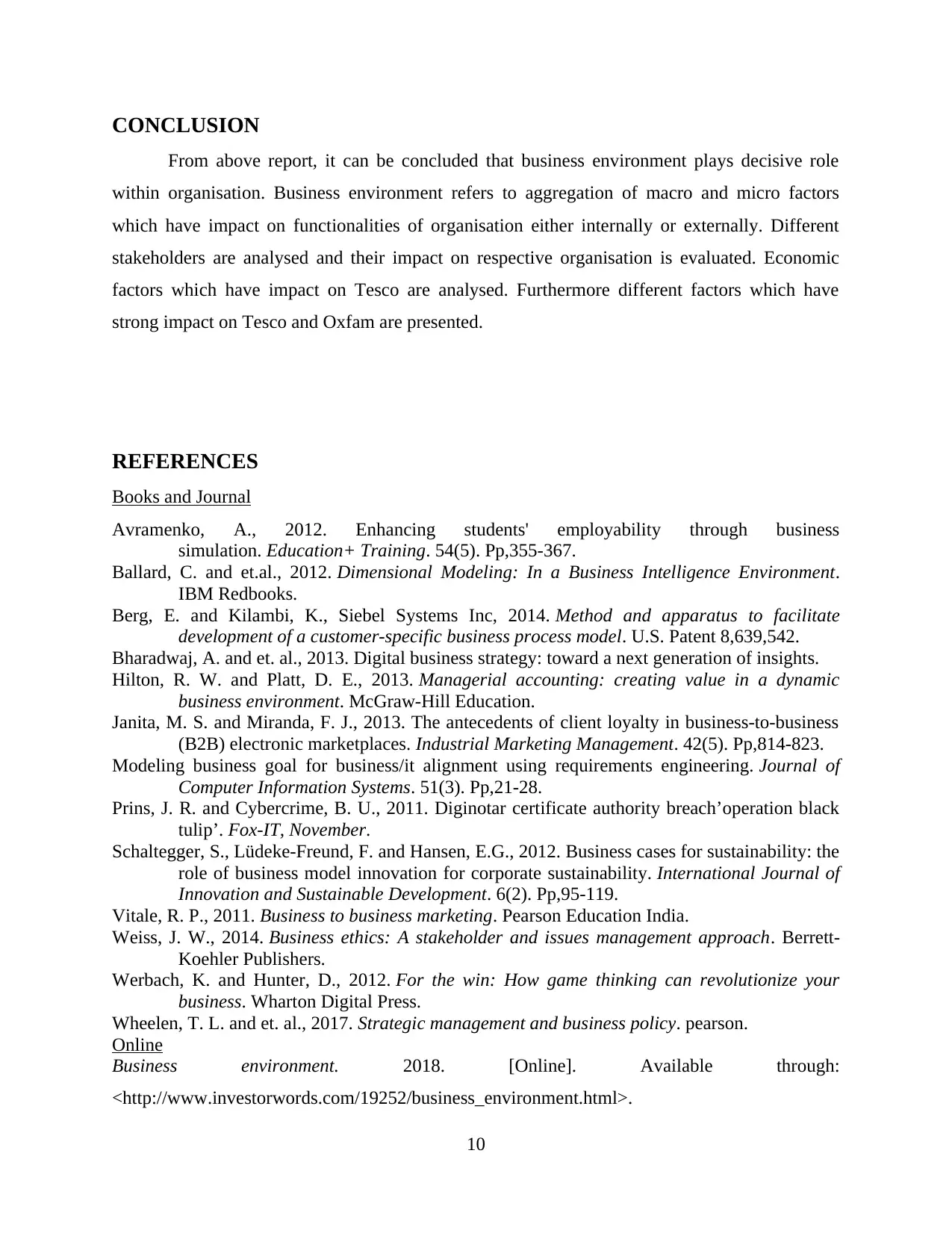
CONCLUSION
From above report, it can be concluded that business environment plays decisive role
within organisation. Business environment refers to aggregation of macro and micro factors
which have impact on functionalities of organisation either internally or externally. Different
stakeholders are analysed and their impact on respective organisation is evaluated. Economic
factors which have impact on Tesco are analysed. Furthermore different factors which have
strong impact on Tesco and Oxfam are presented.
REFERENCES
Books and Journal
Avramenko, A., 2012. Enhancing students' employability through business
simulation. Education+ Training. 54(5). Pp,355-367.
Ballard, C. and et.al., 2012. Dimensional Modeling: In a Business Intelligence Environment.
IBM Redbooks.
Berg, E. and Kilambi, K., Siebel Systems Inc, 2014. Method and apparatus to facilitate
development of a customer-specific business process model. U.S. Patent 8,639,542.
Bharadwaj, A. and et. al., 2013. Digital business strategy: toward a next generation of insights.
Hilton, R. W. and Platt, D. E., 2013. Managerial accounting: creating value in a dynamic
business environment. McGraw-Hill Education.
Janita, M. S. and Miranda, F. J., 2013. The antecedents of client loyalty in business-to-business
(B2B) electronic marketplaces. Industrial Marketing Management. 42(5). Pp,814-823.
Modeling business goal for business/it alignment using requirements engineering. Journal of
Computer Information Systems. 51(3). Pp,21-28.
Prins, J. R. and Cybercrime, B. U., 2011. Diginotar certificate authority breach’operation black
tulip’. Fox-IT, November.
Schaltegger, S., Lüdeke-Freund, F. and Hansen, E.G., 2012. Business cases for sustainability: the
role of business model innovation for corporate sustainability. International Journal of
Innovation and Sustainable Development. 6(2). Pp,95-119.
Vitale, R. P., 2011. Business to business marketing. Pearson Education India.
Weiss, J. W., 2014. Business ethics: A stakeholder and issues management approach. Berrett-
Koehler Publishers.
Werbach, K. and Hunter, D., 2012. For the win: How game thinking can revolutionize your
business. Wharton Digital Press.
Wheelen, T. L. and et. al., 2017. Strategic management and business policy. pearson.
Online
Business environment. 2018. [Online]. Available through:
<http://www.investorwords.com/19252/business_environment.html>.
10
From above report, it can be concluded that business environment plays decisive role
within organisation. Business environment refers to aggregation of macro and micro factors
which have impact on functionalities of organisation either internally or externally. Different
stakeholders are analysed and their impact on respective organisation is evaluated. Economic
factors which have impact on Tesco are analysed. Furthermore different factors which have
strong impact on Tesco and Oxfam are presented.
REFERENCES
Books and Journal
Avramenko, A., 2012. Enhancing students' employability through business
simulation. Education+ Training. 54(5). Pp,355-367.
Ballard, C. and et.al., 2012. Dimensional Modeling: In a Business Intelligence Environment.
IBM Redbooks.
Berg, E. and Kilambi, K., Siebel Systems Inc, 2014. Method and apparatus to facilitate
development of a customer-specific business process model. U.S. Patent 8,639,542.
Bharadwaj, A. and et. al., 2013. Digital business strategy: toward a next generation of insights.
Hilton, R. W. and Platt, D. E., 2013. Managerial accounting: creating value in a dynamic
business environment. McGraw-Hill Education.
Janita, M. S. and Miranda, F. J., 2013. The antecedents of client loyalty in business-to-business
(B2B) electronic marketplaces. Industrial Marketing Management. 42(5). Pp,814-823.
Modeling business goal for business/it alignment using requirements engineering. Journal of
Computer Information Systems. 51(3). Pp,21-28.
Prins, J. R. and Cybercrime, B. U., 2011. Diginotar certificate authority breach’operation black
tulip’. Fox-IT, November.
Schaltegger, S., Lüdeke-Freund, F. and Hansen, E.G., 2012. Business cases for sustainability: the
role of business model innovation for corporate sustainability. International Journal of
Innovation and Sustainable Development. 6(2). Pp,95-119.
Vitale, R. P., 2011. Business to business marketing. Pearson Education India.
Weiss, J. W., 2014. Business ethics: A stakeholder and issues management approach. Berrett-
Koehler Publishers.
Werbach, K. and Hunter, D., 2012. For the win: How game thinking can revolutionize your
business. Wharton Digital Press.
Wheelen, T. L. and et. al., 2017. Strategic management and business policy. pearson.
Online
Business environment. 2018. [Online]. Available through:
<http://www.investorwords.com/19252/business_environment.html>.
10
1 out of 13
Related Documents
Your All-in-One AI-Powered Toolkit for Academic Success.
+13062052269
info@desklib.com
Available 24*7 on WhatsApp / Email
![[object Object]](/_next/static/media/star-bottom.7253800d.svg)
Unlock your academic potential
© 2024 | Zucol Services PVT LTD | All rights reserved.





